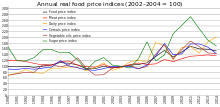Food prices
Food prices refer to the (averaged) price level for food in particular countries or regions or on a global scale. The food industry's contribution to the price levels and fluctuations come from the food production process, food marketing and food distribution. Source of uncontrollable price fluctuations are varying crop yield from excess supply to harvest failure and food speculation activities. It is speculated that already the global climate change could be a major factor behind rising food prices.[1] A continuing drought in South Africa[2] may - amongst other factors - have food inflation soar 11% until end of 2016 according to the South African Reserve Bank.[3] To a certain extent, adverse price trends can be counteracted by food politics. When food commodities become too expensive on the world market, food security is in danger especially for developing countries. In keeping with the supply and demand-principle, global prices will on average continue to rise with the growing world population.
Global differences
Sharp dramatic rises in the food inflation as happened during the 2007-08 world food price crisis have been more pronounced in developing countries than in the OECD and North America in particular, however.[4][5]
Consumer prices in the rich countries are massively influenced by the power of discount stores and constitute only a small part of the entire cost of living. In particular, Western pattern diet constituents like those that are processed by fast food chains are comparatively cheap in the Western hemisphere. Profits rely primarily on quantity (see mass production), less than high-price quality. For some product classes like dairy or meat, overproduction has twisted the price relations in a way utterly unknown in underdeveloped countries ("butter mountain"). The situation for poor societies is worsened by certain free trade agreements that allow easier export of food in the "southern" direction than vice versa. A striking example can be found in tomato exports from Italy to Ghana by virtue of the Economic Partnership Agreements where the artificially cheap vegetables play a significant role in the destruction of indigenous agriculture and a corresponding further decline in the already ailing economic power.[6][7]
Data sources
Numbeo
The Numbeo database "allows you to see, share and compare information about food prices worldwide and gives estimation of minimum money needed for food per person per day".[8]
FAO food price index

The FAO food price index is a measure of the monthly change in international prices of a market basket of food commodities. It consists of the average of five commodity group price indices, weighted with the average export shares of each of the groups for 2002-2004:[9]
- FAO Cereal price index
- FAO Vegetable oil price index
- FAO Dairy price index
- FAO Meat price index
- FAO Sugar Price index
| Year | nominal price idx | deflated price idx |
|---|---|---|
| 1990 | 107.2 | 100.4 |
| 1991 | 105.0 | 98.7 |
| 1992 | 109.2 | 101.1 |
| 1993 | 105.5 | 97.1 |
| 1994 | 110.3 | 101.3 |
| 1995 | 125.3 | 105.3 |
| 1996 | 131.1 | 113.7 |
| 1997 | 120.3 | 111.3 |
| 1998 | 108.6 | 105.6 |
| 1999 | 93.2 | 92.6 |
| 2000 | 91.1 | 92.4 |
| 2001 | 94.6 | 101.0 |
| 2002 | 89.6 | 96.2 |
| 2003 | 97.7 | 98.1 |
| 2004 | 112.7 | 105.0 |
| 2005 | 118.0 | 106.8 |
| 2006 | 127.2 | 112.7 |
| 2007 | 161.4 | 134.6 |
| 2008 | 201.4 | 155.7 |
| 2009 | 160.3 | 132.8 |
| 2010 | 188.0 | 150.7 |
| 2011 | 229.9 | 169.1 |
| 2012 | 213.3 | 158.8 |
| 2013 | 209.8 | 158.5 |
| 2014 | 201.8 | 152.0 |
| 2015 | 164.0 | 123.2 |
| 2016 | 151.6 | 112.3 |
World bank food price watch
The World Bank releases the quarterly Food Price Watch report which highlights trends in domestic food prices in low- and middle-income countries, and outlines the (food) policy implications of food price fluctuations.[10]
See also
- Meat industry, Dairy industry
- Food choice
- Agricultural marketing
- Food waste, Food rescue, Food drive
- Food crisis
- Fast food, Junk food
- Fast-moving consumer goods
- Food riot
- Foodflation
- Nutrition transition
- Global Hunger Index
- Famine
- Commodity risk
- Prices received index, Prices paid index
- Global issues
- "food" and "price"
References
- ↑ "Climate Change: The Unseen Force Behind Rising Food Prices?". World Watch Institute. 2013. Retrieved 2016-06-07.
- ↑ "SA drought persists despite May rainfall". Retrieved 16 June 2016.
- ↑ Thandi Skade (2016-03-29). "SA's ticking food price bomb". destiny man.
- ↑ "Consumer food-price inflation". The Economist. 2014-07-19.
- ↑ "FAO Global and regional consumer food inflation monitoring". FAO.
- ↑ Krupa, Matthias; Lobenstein, Caterina (30 December 2015). "Afrika: Ein Mann pflückt gegen Europa". Retrieved 16 June 2016 – via Die Zeit.
- ↑ https://www.die-gdi.de/uploads/media/Economic_Partnership_Agreements_and_Food_Security.pdf
- ↑ "Numbeo is the world's largest database about food prices worldwide". Retrieved 2016-06-06.
- ↑ "FAO Food Price Index". FAO. Retrieved 2016-06-06.
- ↑ "Food Price Watch:". Retrieved 16 June 2016.
Literature
- Eric Holt-Gimenez , Raj Patel, eds. (2009). Food Rebellions: Crisis and the Hunger for Justice. Food First Books. ISBN 978-0935028348.
- Fast Food Nation: What The All-American Meal is Doing to the World. 2002. ISBN 978-0141006871.
External links
- "1975 food prize study, part 1". prepared by the staff of the Select Committee on Nutrition and Human Needs, United States Senate. 1975.
- "1975 food prize study, part 2". prepared by the staff of the Select Committee on Nutrition and Human Needs, United States Senate. 1975.
- "Food price outlook 2016". Economic Research Service in the U.S. Department of Agriculture.
- "Food prices". Financial Times.